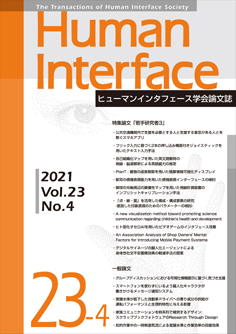Volume 23, Issue 4
Displaying 1-16 of 16 articles from this issue
- |<
- <
- 1
- >
- >|
Papers on Special Issue Subject “Young Researchers 3”
-
Article type: Technical Report
2021Volume 23Issue 4 Pages 373-382
Published: November 25, 2021
Released on J-STAGE: November 25, 2021
Download PDF (6414K) -
Article type: Original Paper
2021Volume 23Issue 4 Pages 383-396
Published: November 25, 2021
Released on J-STAGE: November 25, 2021
Download PDF (2746K) -
Article type: Original Paper
2021Volume 23Issue 4 Pages 397-406
Published: November 25, 2021
Released on J-STAGE: November 25, 2021
Download PDF (3006K) -
Article type: Original Paper
2021Volume 23Issue 4 Pages 407-418
Published: November 25, 2021
Released on J-STAGE: November 25, 2021
Download PDF (11273K) -
Article type: Original Paper
2021Volume 23Issue 4 Pages 419-430
Published: November 25, 2021
Released on J-STAGE: November 25, 2021
Download PDF (1649K) -
Article type: Original Paper
2021Volume 23Issue 4 Pages 431-442
Published: November 25, 2021
Released on J-STAGE: November 25, 2021
Download PDF (3346K) -
Article type: Original Paper
2021Volume 23Issue 4 Pages 443-450
Published: November 25, 2021
Released on J-STAGE: November 25, 2021
Download PDF (5488K) -
Article type: Original Paper
2021Volume 23Issue 4 Pages 451-458
Published: November 25, 2021
Released on J-STAGE: November 25, 2021
Download PDF (5961K) -
Article type: Original Paper
2021Volume 23Issue 4 Pages 459-480
Published: November 25, 2021
Released on J-STAGE: November 25, 2021
Download PDF (1168K) -
Article type: Original Paper
2021Volume 23Issue 4 Pages 481-488
Published: November 25, 2021
Released on J-STAGE: November 25, 2021
Download PDF (538K) -
Article type: Original Paper
2021Volume 23Issue 4 Pages 489-500
Published: November 25, 2021
Released on J-STAGE: November 25, 2021
Download PDF (3949K)
Papers on General Subjects
-
Article type: Original Paper
2021Volume 23Issue 4 Pages 501-512
Published: November 25, 2021
Released on J-STAGE: November 25, 2021
Download PDF (4504K) -
Article type: Original Paper
2021Volume 23Issue 4 Pages 513-524
Published: November 25, 2021
Released on J-STAGE: November 25, 2021
Download PDF (2683K) -
Article type: Original Paper
2021Volume 23Issue 4 Pages 525-534
Published: November 25, 2021
Released on J-STAGE: November 25, 2021
Download PDF (1633K) -
Article type: Original Paper
2021Volume 23Issue 4 Pages 535-546
Published: November 25, 2021
Released on J-STAGE: November 25, 2021
Download PDF (8189K) -
Article type: Original Paper
2021Volume 23Issue 4 Pages 547-558
Published: November 25, 2021
Released on J-STAGE: November 25, 2021
Download PDF (2530K)
- |<
- <
- 1
- >
- >|
